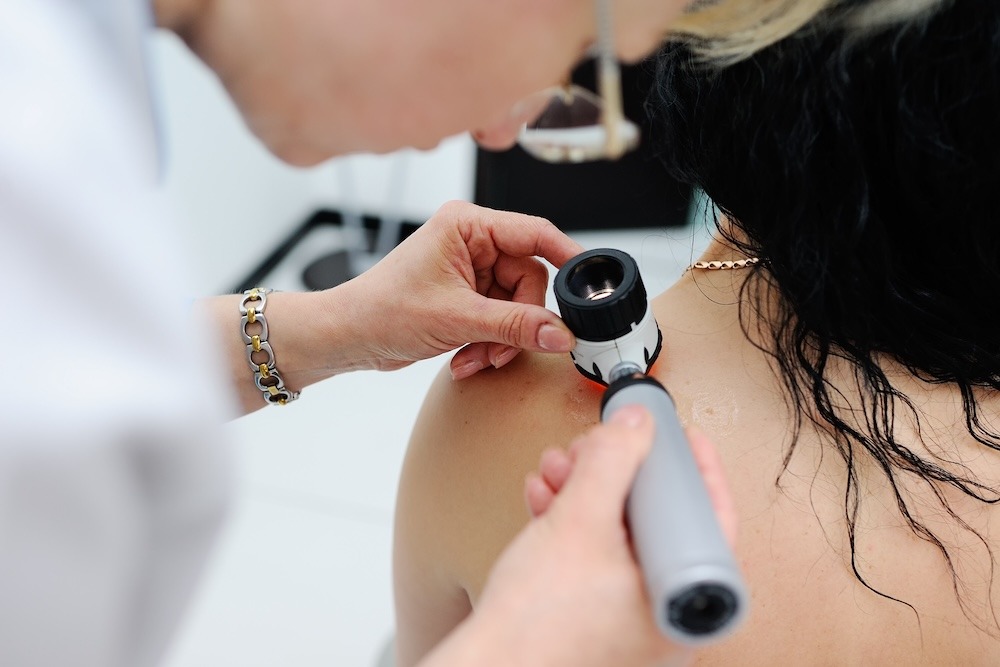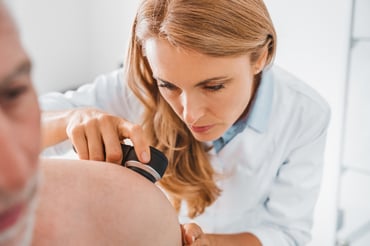
It's normal to be concerned when you discover a new spot or unusual change on your skin. However, it's important to know that not all spots or growths on your skin are cancerous. In fact, most skin growths do not cause problems and never develop into skin cancer, especially when detected early. Knowing what to look for and when to look can help you stop cancer that may appear sooner – when it's easier to treat.
What Is Considered a Precancerous Skin Growth?
Just because you find a new spot on your skin doesn't mean it's skin cancer or even precancerous. Some skin spots are more likely to become cancer if you don't have them treated. These spots usually show up on parts of your skin that get a lot of sun, like your head, hands, and arms.
Older adults, especially those over 40, are more likely to develop these precancerous skin growths due to decades of sun exposure. People over the age of 50 may have been exposed to more sun during their childhood because sunscreen wasn't widely available at that time. However, these growths can also appear at a younger age, especially for those who spend a lot of time in the sun.
What Do Precancerous Skin Growths Look and Feel Like?
There are a few common features of precancerous skin growths. They can appear as unusual bumps, blotches, or spots that weren't there before. You might also notice one or more of the following:
- Slightly raised and small (usually less than one inch in diameter)
- Brown, pink, red, gray, yellow, or white spot
- Crusty, rough, hard, and/or scaly area
- Burning sensation
- Feels tender when touched
- The spot itches
- The spot bleeds without a reason
Common Types of Precancerous Skin Growths
Treatment by a dermatologist can help prevent these types of skin growths from becoming nonmelanoma skin cancer.
- Actinic keratosis (AK): Also sometimes called solar keratosis because they're caused by sun damage, these small, scaly, or crusty patches can be pink, red, or various colors. They usually feel rough, like sandpaper on the skin. They're more common on fair skin.
- Moles: Brown or black skin growths that appear anywhere on the skin. These can be new moles that appear or moles that appeared earlier in life but are changing their shape, color, or texture.
- Atypical moles (Dysplastic Nevi): Generally larger than normal moles and of different shapes. New moles that develop after the age of 25 can also be considered atypical.
Keep in mind, having spots like these doesn't necessarily indicate cancer. However, it’s wise to get it evaluated by your healthcare provider. To be proactive, schedule an annual skin cancer screening with your dermatologist.
Spots or Changes in Your Skin That Are Not Likely Precancerous
You may have other noticeable growths or marks on your body, which are generally harmless and not a cause for concern. These growths can include:
- Freckles: These small brown spots on the face, neck, chest, and arms are very common, especially in light-skinned people or those with light or red hair due to more sun exposure in the summer.
- Age spots: The formal name for these skin discolorations (usually brown) is lentigo which is more common among people with fair skin. Usually caused by sun exposure, some spots are hereditary or caused by radiation therapy. They are often clumped together in an area, have smooth borders, and are painless.
- Skin tags: This is a general term for any small flap of tissue that hangs off your skin. They usually appear on the neck, chest, armpits, groin area, or under the breasts and are more common in women who are overweight and in older people.
- Warts (Seborrheic keratoses): These growths are usually brown, tan, or black and are found on the chest, back, and head. They are more common with age but rarely lead to skin cancer.
- Keloids: Are raised, often thickened scars that form in response to skin trauma, surgery, or injury, especially common in individuals with darker skin tones. Keloids can be treated with radiation to help reduce their size and appearance if they become bothersome.
What Do Cancerous Skin Spots Look Like?
Skin cancer can develop on any part of the body, but it is most likely to occur in areas frequently exposed to the sun, such as the face, head, neck, arms, or legs.
Basal cell cancers usually have these features:
- Scar-like appearance with a yellow tint
- Raised reddish patch
- Non-healing sore
- Pinkish growth with raised edges
- Shiny bump with discoloration
Squamous cell cancers may look like:
- Sores that return or won't heal
- Raised lumps or growths
- Scaly red patches that may bleed
- Wart-like appearance
Melanoma may appear as:
- A new spot on the skin that changes in shape, size, or color
- A spot that doesn't resemble other spots on your body
Signs and symptoms of skin cancer can vary from person to person. If you observe any changes, it's wise to contact your doctor to have them take a look. They may remove the spot and send it to a pathologist who looks at it under a microscope to determine if any cancer cells are present.
The ABCDE Rule for Skin Cancer Detection
Watch the video below to learn about the ABCDE rule for detecting skin cancer.
When To Mention Skin Changes to Your Doctor
It's important to consult with your primary care physician or dermatologist if you discover a skin growth so they can decide if it's precancerous, or even possibly cancer. They will discuss treatment options and how to prevent future growths from developing into cancer.
Detecting skin changes early significantly increases the chances of successful treatment and can prevent the condition from worsening. If you notice any changes in your skin, schedule a consultation with your doctor or dermatologist right away. Skin changes that warrant an appointment may include:
- A sore that won't heal
- Growth or spread of an existing mole
- New growths on the skin that resemble precancerous changes
- Skin that is bleeding or swelling
Treatments for skin changes can vary and may include medications, freezing, light therapy, or in-office surgical procedures. Cells removed during the process may be tested for signs of cancer.
Types of Skin Cancer That Can Develop
If cancer is found in the cells, it will most likely be one of the following:
- Basal cell carcinoma: The most common form of skin cancer, easily treatable if found early.
- Squamous cell carcinoma: Although less common, this type of skin cancer can be very serious if it spreads. Squamous cell carcinoma is treatable, with a cure rate of over 90% if detected early.
- Melanoma: A severe and fast-spreading form of skin cancer. Early forms like lentigo maligna can progress into melanoma if left untreated.
If a biopsy reveals that a growth is cancerous, try not to worry. Your doctor may recommend an additional surgical procedure to remove the surrounding tissue. This process ensures that all cancer cells are eliminated which lowers the likelihood of the cancer continuing to grow in that area.
Consultation with an oncologist may also be needed for additional cancer treatments.
Reduce Your Risk of Skin Cancer
The best way to reduce your risk of skin cancer is by protecting your skin. You can achieve this by minimizing your exposure to the sun. When outdoors, wear appropriate clothing, hats, and sunglasses, and seek shade whenever possible. It is important to use sunscreen with at least SPF 30, even on cloudy days. Additionally, avoid tanning beds and ensure you schedule regular skin screenings if you are over 40.
While self-exams can be useful, a doctor can provide a more comprehensive examination. Regular skin cancer screenings are essential to ensure that your skin is healthy and free of cancer.
Skin Cancer Treatment Specialists in the Atlanta Area
If you are diagnosed with skin cancer and live in the Atlanta area, our oncologists are available to provide radiation therapy, if that is a part of your skin cancer treatment plan. We have locations in Conyers, Covington, Decatur, and Snellville, making it convenient for you to receive therapy close to home or work.
You can request an appointment at one of our locations to schedule an initial consultation or a second opinion appointment with our radiation oncologists.



